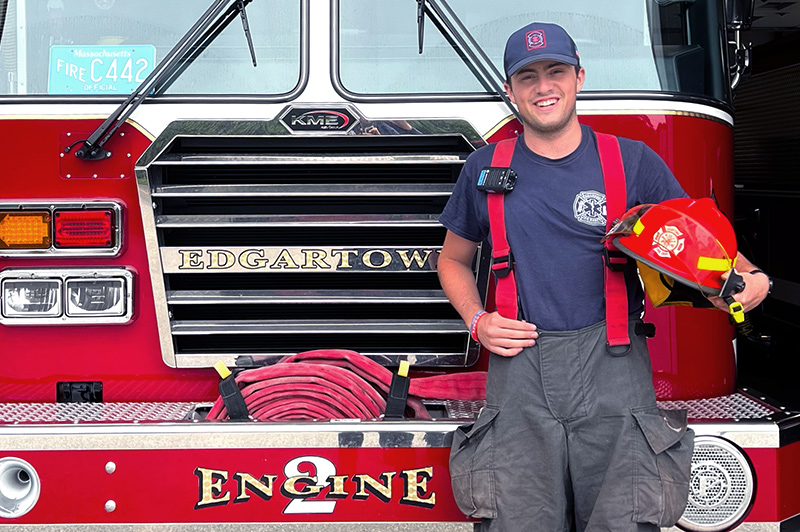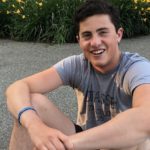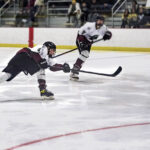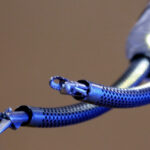From pain to purpose: An update on Dylan’s traumatic brain injury

We first introduced you to Dylan four years ago, when a traumatic brain injury led him to the Department of Neurosurgery for care and instilled in him a love of medicine. We caught up with the college senior this summer to see where life has taken him since he started an internship with the team he credits for saving his life. Here, in his own words, Dylan shares an update about the journey that’s shaped him.
Looking back as I move forward
It’s mind-blowing to think that I’m a few weeks into my senior year of college. People say that time flies by, and as a kid, that’s an easy idea to dismiss. Suddenly, time really does fly.
Looking back on the last four years since my brain injury and my first experience with Boston Children’s, I feel incredibly fortunate to have been introduced to the organization (despite how I got here) and to have spent the last few summers working as an intern in the Department of Neurosurgery. I like to think of it as the start of the journey that molded my path forward.
For the past few summers, I’ve been working alongside other research assistants on various projects, including a comprehensive database of all patients treated by the Cerebrovascular Surgery and Interventions Center team since the late 1990s. This includes children who have been treated for moyamoya disease, brain aneurysms, and more. We’re analyzing longitudinal data on how these patients were treated to see if we can draw links between prior medical histories and outcomes later in life. Our goal is to help shape how we best approach pediatric neurosurgical care.
It’s truly been a privilege to work under some of the greatest pediatric neurosurgeons in the world; this opportunity has been life-changing, and I’m grateful the team took a chance on me.
Learning to help from the other side of the hospital bed
As my journey has evolved, I’ve embraced a two-pronged approach to my medical career. On the one hand, there’s the academic and clinical side — the research, the time in the OR — but there’s also nothing like being in the back of an ambulance and treating patients right in front of you. So, I went to EMT school after my freshman year and am now a firefighter/EMT in Edgartown, Massachusetts.
It’s a really powerful thing to get your EMT license at 18 and be able to have a patient under your care; it’s a very real and serious responsibility.
Being an EMT and a research assistant presents a weird dichotomy in my life. On the one hand, I’m treating patients acutely and making crucial decisions on the spot. On the other hand, however, I am helping push the boundaries of what we know pediatric care to be through my research. To me, it’s the best of both worlds.
Remembering where I came from through patient advisory
As much as I value my roles as a research assistant and as a firefighter/EMT, and appreciate what they’re teaching me about patient care and caring for people, it’s my role on the Neurosciences Family Advisory Council (NFAC) that keeps me grounded the most.
I joined NFAC in 2019 while I was navigating my traumatic brain injury care and became the co-chair shortly thereafter. NFAC is a fantastic group of current and former patients, families (myself and my parents included), and neuroscience staff who are working together to improve patients’ quality of care, safety, and patient experience.
I’m incredibly proud to be part of such an amazing group of people who’ve been able to work on impactful initiatives such as the Eversource Walk for Kids and a webinar series called “After the Diagnosis,” which discusses different neuroscience diagnoses families face and how they deal with them.
How it all comes together
Being part of NFAC forces me to reckon with how my different identities fit together. They may seem unbelievably different, but at the end of the day, they’re explicitly connected. I go from health care on the street to one of the most well-respected institutions in the world to working with patients and families as one of their own. I think it’s all with the same purpose: I just want to do good for somebody and make them feel heard and understood.
If the last four years have taught me anything, it’s that everything can change in a second. Still, when I think back to how much I was struggling after my injury, I remember the promise I made to myself: that if I had this second shot at life, I needed to do something really good with it. I still try and live by that promise every day: I try to make somebody’s day better, and what better way to do that than in medicine, where you are dedicating your entire life towards the service of others. Because that’s what we’re here to do. I think that’s the promise of medicine.
Learn more about the Department of Neurosurgery and the Neuroscience Family Advisory Council.
Related Posts :
-

Freak accident leads to Dylan’s passion for neurosurgery
It was the summer of 2019. Dylan Keusch had just graduated from prep school and was planning to major in Industrial ...
-

Thinking – and operating – outside the box: Bypassing Saoirse’s aneurysm
Saoirse just turned 3. There was a big to-do for her birthday, complete with family flying to Massachusetts from Ireland for ...
-

Varsity blues: How AVM radiation therapy got Greta back to sports
Want to find Greta? Try the hockey rink, or softball field, or volleyball court. Where won’t you find her? ...
-

This two-handed robot goes deep into the brain
Robots have become common partners in the OR, enabling surgeons to operate through small incisions and manipulate tools endoscopically, avoiding ...





